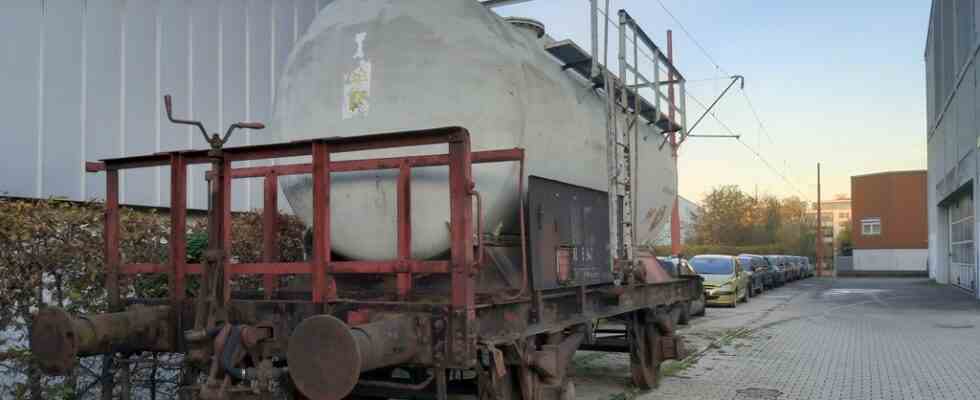They get lost in the undergrowth, run under concrete slabs or gravel walls, lead into workshops and commercial yards. They end at a forgotten buffer stop or at the red and white striped railings of former crossings: like the delta, disused or extremely rarely used railway tracks run through the district of Obersendling and its immediate vicinity.
Discovering these relics of the industrial age and decoding their systematics is the initial task of the newly founded history workshop in Munich-South. A lecture by railway enthusiast Jochen Gottlieb on the topic “From Bochum to the hot hut” in the Südpark neighborhood meeting point was, so to speak, the starting signal and met with a great response. “The attempt was successful, there is obviously a great need for historical knowledge,” stated Rudolf Zirngibl, one of the initiators.
The impressively illustrated presentation could have been given a different name. “How the Ruhrpott overran the Mittersendling train station”, for example. In 1966, this station, which had existed since 1854, had an incredible ten tracks and a stately loading ramp. An important reason: at full steam, the train shoveled vacationers from western Germany, who changed trains at this junction in the direction of the Alps. Legendary direct connection: Dortmund – Sendling.
For decades the steel giant Bochumer Verein (BVG), which later merged with Krupp, was the big train in freight traffic that was handled in Mittersendling. This company supplied all the rails that were laid for kilometers in Obersendling. Here and there the logo of the company is still clearly visible, even on the heads of nails.
The trains sometimes went directly to the affiliated companies.
(Photo: Jochen Gottlieb)
Most of the tracks are no longer used.
(Photo: Jochen Gottlieb)
The residential development has moved very close to the old railway facilities.
(Photo: Jochen Gottlieb)
The rail lines, with which Obersendling was developed for rail traffic, cut through the quarter in three main arteries and several side tracks. Even in the years between the wars, but especially during the period of the economic miracle, every self-respecting company demanded its own railway connection. Such companies have long concentrated in Obersendling. Siemens, Philip Morris, Perutz, Agfa, Klüber, Isar-Amperwerke, Eon, Katzenberger, Kaspar Walter Maschinenbau are just a few of the illustrious names. Even juice producers and cardboard box manufacturers appear as breakpoints. In industrial peak times, locomotives and freight cars shunted in front of the loading ramps of 40 companies. Many of them have long since turned their backs on the south of Munich and made room for housing and office use. A competing means of transport, the truck, also gradually reduced the importance of the railway in the south of Munich.
In the heyday of the commercial location, however, the Kistlerhofstraße combined heat and power plant (today the Kare furniture store) was attached to the rail network and thus ensured its oil supply. A highway office, the municipal wood yard and the fire station on Aidenbachstrasse were also targets for rail expansion. To this day, an old tank wagon is used by firefighters for training purposes. The locomotives that appeared in Obersendling are legendary among connoisseurs. For example, the “Köf” (small locomotive with oil motor and liquid transmission) built between 1933 and 1978, or the squeaking V 60, which tended to “slip” in the rain, i.e. derailed when the curve radius became tight.
Overgrown tracks can be found in the present as natural areas.
(Photo: Jochen Gottlieb)
Pushing and pulling prohibited: Old signs are reminiscent of the railway past.
(Photo: Jochen Gottlieb)
If you were a retired route walker or one of those former railway employees who stopped traffic when crossing trains by waving flags, you would be wistfully reminded of a Christian Anders hit in Obersendling: “There’s a train going nowhere.” As a conservationist, on the other hand, you would be delighted with the condition of some of the routes – they resemble luxuriantly flourishing biotopes. “You could only get through there with a machete,” Jochen Gottlieb found out on his walks.
think big That was the maxim of big industrialists and building contractors on the threshold of the 20th century. They were called Baron von Finck or Jakob Heilmann. Their vision: to set the course for the development of a gigantic industrial area in the south of Munich through the construction of a hydroelectric power plant on the Isar and the targeted development of transport by rail. Her plan was to work in Obersendling, for decades unlimited growth seemed to be an option. The founders of so-called “terrain companies” did not live to see the change to a service society. But the traces they left behind are still evident to this day.
Oh yes, and what about the “hot hut” from the lecture title? The establishment on Kistlerhofstraße, which was also known as the “Blue Lagoon” until the noughties, had very little in common with a sausage stand. Rather, the name concealed a mini brothel. Easily accessible in its day by car rather than by train.

